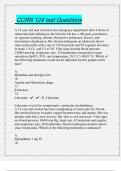Examen
CCRN 124 test Questions With 100% Correct Solutions|64 Pages
- Cours
- Établissement
A 72-year-old man arrived in the emergency department after 4 hours of substernal pain radiating to the left arm. He has a 100 pack-year history of cigarette smoking, chronic obstructive pulmonary disease, and intermittent claudication. His electrocardiogram on admission shows sinus tachycardia wit...
[Montrer plus]



